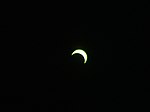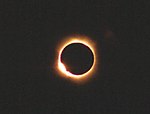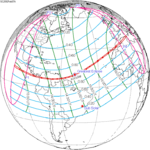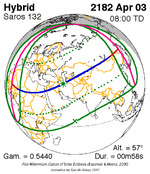Solar eclipse of December 14, 2001
| Solar eclipse of December 14, 2001 | |
|---|---|
 Partial from Minneapolis, Minnesota | |
| Type of eclipse | |
| Nature | Annular |
| Gamma | 0.4089 |
| Magnitude | 0.9681 |
| Maximum eclipse | |
| Duration | 233 s (3 min 53 s) |
| Coordinates | 0°36′N 130°42′W / 0.6°N 130.7°W |
| Max. width of band | 126 km (78 mi) |
| Times (UTC) | |
| Greatest eclipse | 20:53:01 |
| References | |
| Saros | 132 (45 of 71) |
| Catalog # (SE5000) | 9512 |
An annular solar eclipse occurred on December 14, 2001. A solar eclipse occurs when the Moon passes between Earth and the Sun, thereby totally or partly obscuring the image of the Sun for a viewer on Earth. An annular solar eclipse occurs when the Moon's apparent diameter is smaller than the Sun's, blocking most of the Sun's light and causing the Sun to look like an annulus (ring). An annular eclipse appears as a partial eclipse over a region of the Earth thousands of kilometres wide. It was visible across the Pacific ocean, southern Costa Rica, northern Nicaragua and San Andrés Island, Colombia. The central shadow passed just south of Hawaii in early morning and ended over Central America near sunset. This is the first solar eclipse to occur since the September 11, 2001 attacks.
The moon's apparent diameter was near the average diameter because the eclipse occurred 7.9 days after perigee (December 6, 2001 at 22:49 UTC) and 6.7 days before apogee (December 21, 2001 at 13:03 UTC).
Images
Gallery
-
Partial from Siesta Key, Florida at sunset
Related eclipses
Eclipses of 2001
- A total lunar eclipse on January 9.
- A total solar eclipse on June 21.
- A partial lunar eclipse on July 5.
- An annular solar eclipse on December 14.
- A penumbral lunar eclipse on December 30.
Tzolkinex
- Preceded: Solar eclipse of November 3, 1994
- Followed: Solar eclipse of January 26, 2009
Half-Saros
- Preceded: Lunar eclipse of December 9, 1992
- Followed: Lunar eclipse of December 21, 2010
Tritos
- Preceded: Solar eclipse of January 15, 1991
- Followed: Solar eclipse of November 13, 2012
Solar Saros 132
- Preceded: Solar eclipse of December 4, 1983
- Followed: Solar eclipse of December 26, 2019
Inex
- Preceded: Solar eclipse of January 4, 1973
- Followed: Solar eclipse of November 25, 2030
Solar eclipses 2000–2003
This eclipse is a member of a semester series. An eclipse in a semester series of solar eclipses repeats approximately every 177 days and 4 hours (a semester) at alternating nodes of the Moon's orbit.[1]
The partial solar eclipses on February 5, 2000 and July 31, 2000 occur in the previous lunar year eclipse set.
| Solar eclipse series sets from 2000 to 2003 | ||||||
|---|---|---|---|---|---|---|
| Ascending node | Descending node | |||||
| Saros | Map | Gamma | Saros | Map | Gamma | |
| 117 | July 1, 2000 Partial |
−1.28214 | 122 Partial projection in Minneapolis, MN, USA |
December 25, 2000 Partial |
1.13669 | |
127 Totality in Lusaka, Zambia |
June 21, 2001 Total |
−0.57013 | 132 Partial in Minneapolis, MN, USA |
December 14, 2001 Annular |
0.40885 | |
137 Partial in Los Angeles, CA, USA |
June 10, 2002 Annular |
0.19933 | 142 Totality in Woomera, South Australia |
December 4, 2002 Total |
−0.30204 | |
147 Annularity in Culloden, Scotland |
May 31, 2003 Annular |
0.99598 | 152
|
November 23, 2003 Total |
−0.96381 | |
Saros 132
This eclipse is a part of Saros series 132, repeating every 18 years, 11 days, and containing 71 events. The series started with a partial solar eclipse on August 13, 1208. It contains annular eclipses from March 17, 1569 through March 12, 2146; hybrid eclipses on March 23, 2164 and April 3, 2182; and total eclipses from April 14, 2200 through June 19, 2308. The series ends at member 71 as a partial eclipse on September 25, 2470. Its eclipses are tabulated in three columns; every third eclipse in the same column is one exeligmos apart, so they all cast shadows over approximately the same parts of the Earth.
The longest duration of annularity was produced by member 25 at 6 minutes, 56 seconds on May 9, 1641, and the longest duration of totality will be produced by member 61 at 2 minutes, 14 seconds on June 8, 2290. All eclipses in this series occur at the Moon’s descending node of orbit.[2]
| Series members 34–56 occur between 1801 and 2200: | |||
|---|---|---|---|
| 34 | 35 | 36 | |
 August 17, 1803 |
 August 27, 1821 |
 September 7, 1839 | |
| 37 | 38 | 39 | |
 September 18, 1857 |
 September 29, 1875 |
 October 9, 1893 | |
| 40 | 41 | 42 | |
 October 22, 1911 |
 November 1, 1929 |
 November 12, 1947 | |
| 43 | 44 | 45 | |
 November 23, 1965 |
 December 4, 1983 |
 December 14, 2001 | |
| 46 | 47 | 48 | |
 December 26, 2019 |
 January 5, 2038 |
 January 16, 2056 | |
| 49 | 50 | 51 | |
 January 27, 2074 |
 February 7, 2092 |
 February 18, 2110 | |
| 52 | 53 | 54 | |
 March 1, 2128 |
 March 12, 2146 |
 March 23, 2164 | |
| 55 | 56 | ||
 April 3, 2182 |
 April 14, 2200 | ||
Tritos series
This eclipse is a part of a tritos cycle, repeating at alternating nodes every 135 synodic months (≈ 3986.63 days, or 11 years minus 1 month). Their appearance and longitude are irregular due to a lack of synchronization with the anomalistic month (period of perigee), but groupings of 3 tritos cycles (≈ 33 years minus 3 months) come close (≈ 434.044 anomalistic months), so eclipses are similar in these groupings.
| Series members between 1901 and 2100 | |||
|---|---|---|---|
 September 21, 1903 (Saros 123) |
 August 21, 1914 (Saros 124) |
 July 20, 1925 (Saros 125) | |
 June 19, 1936 (Saros 126) |
 May 20, 1947 (Saros 127) |
 April 19, 1958 (Saros 128) | |
 March 18, 1969 (Saros 129) |
 February 16, 1980 (Saros 130) |
 January 15, 1991 (Saros 131) | |
 December 14, 2001 (Saros 132) |
 November 13, 2012 (Saros 133) |
 October 14, 2023 (Saros 134) | |
 September 12, 2034 (Saros 135) |
 August 12, 2045 (Saros 136) |
 July 12, 2056 (Saros 137) | |
 June 11, 2067 (Saros 138) |
 May 11, 2078 (Saros 139) |
 April 10, 2089 (Saros 140) | |
 March 10, 2100 (Saros 141) |
|||
Metonic cycle
The metonic series repeats eclipses every 19 years (6939.69 days), lasting about 5 cycles. Eclipses occur in nearly the same calendar date. In addition, the octon subseries repeats 1/5 of that or every 3.8 years (1387.94 days). All eclipses in this table occur at the Moon's descending node.
| 21 eclipse events between July 22, 1971 and July 22, 2047 | ||||
|---|---|---|---|---|
| July 22 | May 9–11 | February 26–27 | December 14–15 | October 2–3 |
| 116 | 118 | 120 | 122 | 124 |
 July 22, 1971 |
 May 11, 1975 |
 February 26, 1979 |
 December 15, 1982 |
 October 3, 1986 |
| 126 | 128 | 130 | 132 | 134 |
 July 22, 1990 |
 May 10, 1994 |
 February 26, 1998 |
 December 14, 2001 |
 October 3, 2005 |
| 136 | 138 | 140 | 142 | 144 |
 July 22, 2009 |
 May 10, 2013 |
 February 26, 2017 |
 December 14, 2020 |
 October 2, 2024 |
| 146 | 148 | 150 | 152 | 154 |
 July 22, 2028 |
 May 9, 2032 |
 February 27, 2036 |
 December 15, 2039 |
 October 3, 2043 |
| 156 | ||||
 July 22, 2047 | ||||
Notes
- ^ van Gent, R.H. "Solar- and Lunar-Eclipse Predictions from Antiquity to the Present". A Catalogue of Eclipse Cycles. Utrecht University. Retrieved 6 October 2018.
- ^ "NASA - Catalog of Solar Eclipses of Saros 132". eclipse.gsfc.nasa.gov.
References
- NASA Press release: Annular Solar Eclipse of 2001 December 14
- Earth visibility chart and eclipse statistics Eclipse Predictions by Fred Espenak, NASA/GSFC
Photos:
- Photos of solar eclipse around the world
- NASA Astronomy Picture of the Day: Partial Eclipse, Cloudy Day, near Des Moines, Iowa (21 December 2001)
- Partial Solar Eclipse from the USA
- SpaceWeather.com Dec 14, 2001, Solar Eclipse Gallery and [1]






